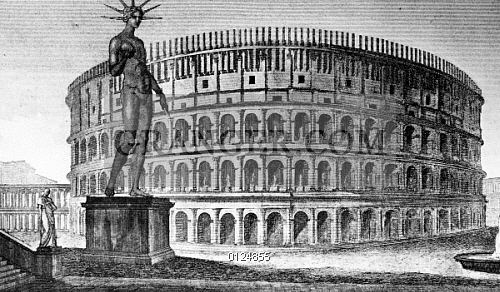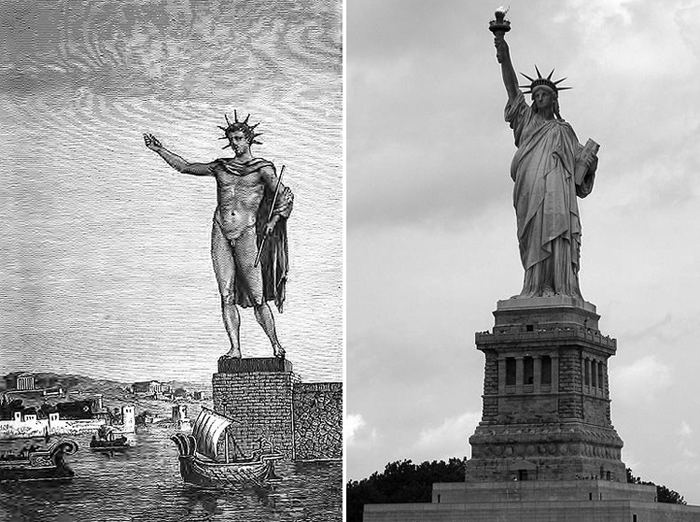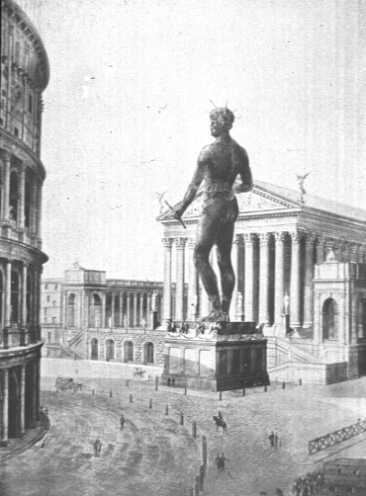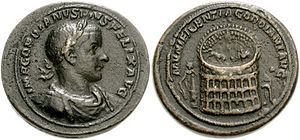 | ||
Similar Domus Aurea, Temple of Venus and Roma, Meta Sudans, Amphitheatrum Castrense, Velarium | ||
The Colossus of Nero (Colossus Neronis) was a 30-metre (98 ft) bronze statue that the Emperor Nero (37–68 AD) created in the vestibule of his Domus Aurea, the imperial villa complex which spanned a large area from the north side of the Palatine Hill, across the Velian ridge to the Esquiline Hill. It was modified by Nero's successors into a statue of the sun god Sol. It is last mentioned in the 4th century AD. The statue was eventually moved to a spot outside the Flavian Amphitheatre, which (according to one of the more popular theories) became known, by its proximity to the Colossus, as the Colosseum.
Contents
- Outside view of the colossus of nero
- Construction
- Change to Colossus Solis
- Fate of the Colossus
- Connection to Colosseum
- References

Outside view of the colossus of nero
Construction

The statue was placed just outside the main palace entrance at the terminus of the Via Appia in a large atrium of porticoes that divided the city from the private villa. The Greek architect Zenodorus designed the statue and began construction between A.D. 64 and 68. According to Pliny the Elder, the statue reached 106.5 Roman Feet (30.3 metres (99 ft)) in height, though other sources claim it was as much as 37 metres (121 ft).
Change to Colossus Solis

Shortly after Nero's death in A.D. 68, the Emperor Vespasian added a sun-ray crown and renamed it Colossus Solis, after the Roman sun god Sol. Around 128, Emperor Hadrian ordered the statue moved from the Domus Aurea to just northwest of the Colosseum (Amphitheatrum Flavianum), in order to create space for the Temple of Venus and Roma. It was moved by the architect Decrianus with the use of 24 elephants. Emperor Commodus converted it into a statue of himself as Hercules by replacing the head, but after his death it was restored, and so it remained.
Fate of the Colossus

The last mention from antiquity of the statue is the reference in the Chronography of 354. Today, nothing remains of the Colossus of Nero save for the foundations of the pedestal at its second location near the Colosseum. It was possibly destroyed during the Sack of Rome in 410, or toppled in one of a series of fifth-century earthquakes, and its metal scavenged. However, it is also possible that the statue was still standing during the Middle Ages, because a preserved medieval poem says: As long as the Colossus stands, Rome will stand, when the Colossus falls, Rome will also fall, when Rome falls, so falls the world.

The remains of the brick-faced masonry pedestal, once covered with marble, were removed in 1936. The foundations were excavated in 1986, and can be viewed by the public.
Connection to Colosseum
Many experts agree that the name for the Colosseum is derived from this monument.

Bede (c. 672–735) wrote a famous epigram celebrating the symbolic significance of the statue, Quandiu stabit coliseus, stabit et Roma; quando cadit coliseus, cadet et Roma; quando cadet Roma, cadet et mundus ("as long as the Colossus stands, so shall Rome; when the Colossus falls, Rome shall fall; when Rome falls, so falls the world"). This is often mistranslated to refer to the Colosseum rather than the Colossus (as in, for instance, Byron's poem Childe Harold's Pilgrimage). However, at the time that Bede wrote, the masculine noun coliseus was applied to the statue rather than to what was still known as the Flavian Amphitheatre.
